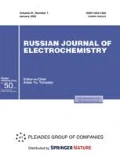Abstract
In this paper, the growth process of T2 brass passive film in generator cooling water was studied, the effect of CO2’s leakage on the crystal structure and anti-corrosion performance of passive film was analyzed, and we were trying to repair the passive film by adjusting pH of solution. Electrochemical Impedance Spectroscopy (EIS), Potentiodynamic Polarization (PP), Potentiostatic Scan (PS), Scanning Electron Microscopy (SEM) and X-ray Photoelectron Spectroscopy (XPS) were used in this paper. The test results showed that a thin and dense Cu2O passive film was formed on the surface of T2 brass after immersed in the cooling water for 2 days. And then a loose CuO outside layer was formed gradually, during this period the Cu2O was further oxidized to be CuO, the dense structure of the inner Cu2O layer was thus damaged. Finally a double-layer passive film consisted by Cu2O and CuO was formed at the 24th day of immersed. Corrosion pits and cracks appeared on the outside passive film after erosed by CO2. The anti-corrosion performance of the passive film cannot be completely restored by self in alkaline solution.













Similar content being viewed by others
REFERENCES
Wang, S., Research on Corrosion Protection of Inner Cooling Water System in Generator, Changsha: Changsha Univ. of Science and Technology, 2010.
Svoboda, R. and Plamer, D.A., Behavior of copper in generator stator cooling-water systems, Power Plant Chem., 2009, vol. 11, pp. 70–76.
Duffeau, F., Aspden, D., and Coetzee, G., Guide on stator water chemistry management, Study Comm., 2010, vol. 4, pp. 37–41.
Prevention of Flow Restrictions in Generator Stator Water Cooling Circuits, EPRI, 2002.
Schleithoff, K. and Emshoff, H.W., Optimization of the conditioning of generator cooling water, VGB Kraftswerktechnik, 1990, vol. 70, pp. 677–681.
Robert, S. and Donald, A.P., Behaviour of copper in generator stator cooling-water systems, Proc. 15th ICPWS, Berlin, Sept. 2008, pp. 8–11.
Syrett, B., Electrochemical Corrosion Potential (ECP) of Hollow Copper Strands in Water Cooled Generator, EPRI, 2007.
Tyapkov, V.F., Chudakova, I.Y., and Alekseenko, O.A., Achieving more reliable operation of turbine generators at nuclear power plants by improving the water chemistry of the generator stator cooling system, Therm. Eng., 2011, vol. 58, pp. 655–659.
Svoboda, R. and Seipp, H.G., Flow restrictions water cooled generator stator coils-prevention, diagnosis, and removal. Part 1: behavior of copper in water cooled generator coils, Power Plant Chem., 2004, vol. 6, pp. 7–14.
Wei, Y.J., Xia, D.H., and Song, S.Z., Detection of SCC of 304 NG stainless steel in an acidic NaCl solution using electrochemical noise based on chaos and wavelet analysis, Russ. J. Electrochem., 2016, vol. 52, pp. 560–575.
Sharon, P.M. and Felix, W.R.M., Operating experience gained during the copper oxide plugging incident in Koeberg Unit1 generation stator, Power Plant Chem., 2001, vol. 3, pp. 262–269.
Yuan, Z.D., The effects of abrasive particles on the electrochemical behavior of adrenaline at different electrodes, Russ. J. Electrochem., 2014, vol. 50, pp. 80–86.
Ding, H.Y., Feng, Y.J., and Lu, J.W., Study on the service life and deactivation mechanism of Ti/SnO2–Sb Electrode by physical and electrochemical methods, Russ. J. Electrochem., 2010, vol. 46, pp. 72–76.
Rui, Y.Z. and Shun, A.C., Copper corrosion behavior in stator cooling water, Mater. Perform., 2016, vol. 55, pp. 46–50.
Ye, C.S., Zhang, J., and Qian, Q., Quasi-dynamicsimulation test of corrosion control for generator copper conductors, Corros. Sci. Protect. Technol., 2004, vol. 16, pp. 41–43.
Zha, F.L., Feng, B., and Xu, S., Electrochemical corrosion behavior of copper in soil extract solution, Corros. Sci. Protect. Technol., 2014, vol. 26, pp. 446–450.
Xu, Q.J., Zhu, L.J., and Qi, H., Photoelectrochemical study of the corrosion and inhibition on Cu, Acta Metallurg. Sin., 2008, vol. 44, pp. 1360–1365.
Cao, F.H., Len, V.H., Zhang, Z., and Zhang, J.Q., Corrosion behavior of magnesium and its alloy in NaCl solution, Russ. J. Electrochem., 2007, vol. 43, pp. 837–843.
Dai, J., Hu, L.H., and Liu, W.Q., Study on the flat band potential of nanoporous TiO2 film electrode, Acta Phys. Sin., 2008, vol. 57, pp. 5310–5316.
Q, D.Z., Rohwerder, M., and Zhao, Z., Semiconducting behavior of temporararily protective oil coating on the surface of AISI 304 stainless steel in 5% Na2SO4 solution during its degradation, J. Electrochem. Soc., 2004, vol. 151, pp. B446–B452.
Ortiz, R., Ogura, T., and Valtierra, J.M., A catalytic application of Cu2O and CuO films deposited over fiberglass, Appl. Surf. Sci., 2001, vol. 174, pp. 177–184.
Du, G., Li, J., Wang, W.K., Jiang, C., and Song, S.Z., Detection and characterization of stress-corrosion cracking on 304 stainless steel by electrochemical noiseand acoustic emission techniques, Corros. Sci., 2011,vol. 53, pp. 2918–2926.
Kuleshova, N.E., Vvedenskii, A.V., and Bobrinskaya, E.V., Anodic oxidation of serine anion on smooth and platinized platinum, Russ. J. Electrochem., 2018, vol. 54, pp. 529–597.
Ma, C., Zhou, B., Xia, D.H., et al., In-situ study the corrosion degradation mechanism of tinplate in salty water by scanning electrochemical microscopy, Russ. J. Electrochem., 2018, vol. 54, pp. 216–223.
Ojani, R., Raoof, J.B., and Hosseini Zavvarmahalleh, S.R., Electrocatalytic oxidation of methanol on carbon paste electrode modified by nickel ions dispersed into poly(1,5-diaminonaphthalene) film, Electrochim. Acta, 2008, vol. 53, no. 5, pp. 2402–2407.
Norouzi, B. and Mirkazemi, T., Electrochemical sensor for amoxicillin using Cu/poly (o-toluidine) (sodium dodecyl sulfate) modified carbon paste electrode, Russ. J. Electrochem., 2016, vol. 52, no. 1, pp. 37–45.
ACKNOWLEDGMENTS
This work was supported by Science-Technology Innovation Platform and Talents Program of Hunan Province, China (2016TP12027).
Author information
Authors and Affiliations
Corresponding author
Ethics declarations
The authors declare that they have no conflict of interest.
Rights and permissions
About this article
Cite this article
Bing Feng, Zha, F., Li, L. et al. The Corrosion Behavior of T2 Brass in Power Plant Generator Stator Cooling Water. Russ J Electrochem 55, 943–952 (2019). https://doi.org/10.1134/S1023193519100033
Received:
Revised:
Accepted:
Published:
Issue Date:
DOI: https://doi.org/10.1134/S1023193519100033




